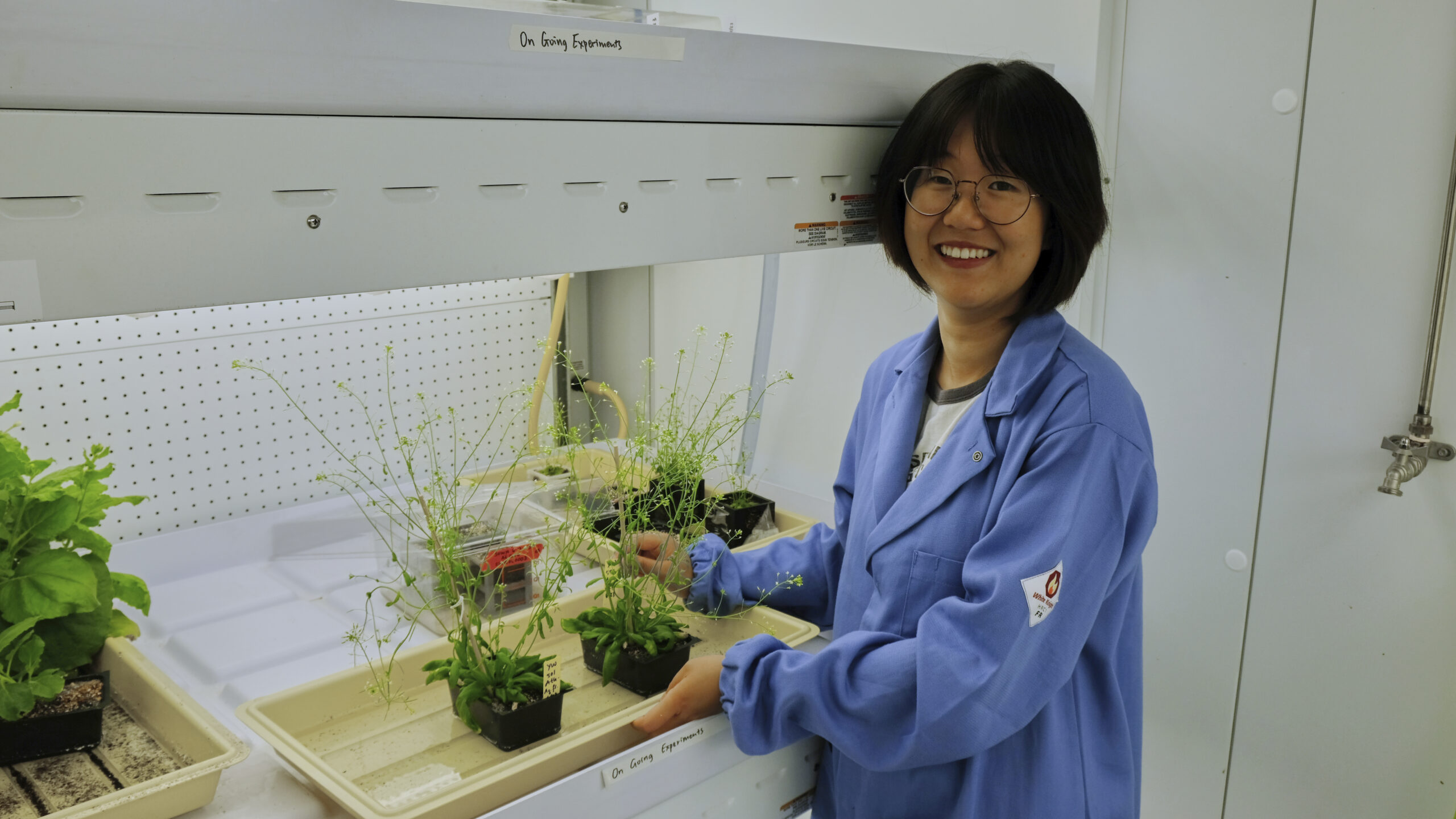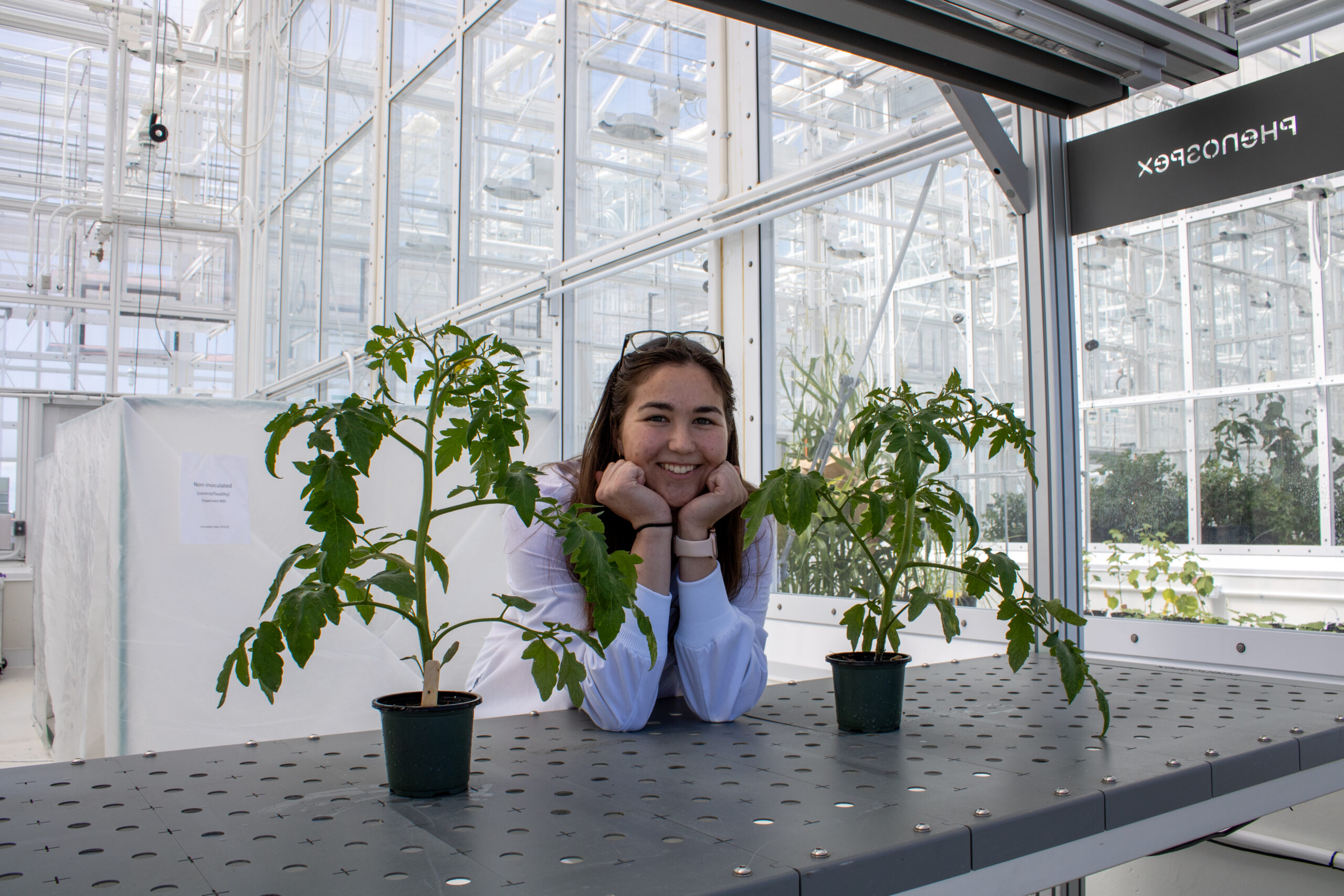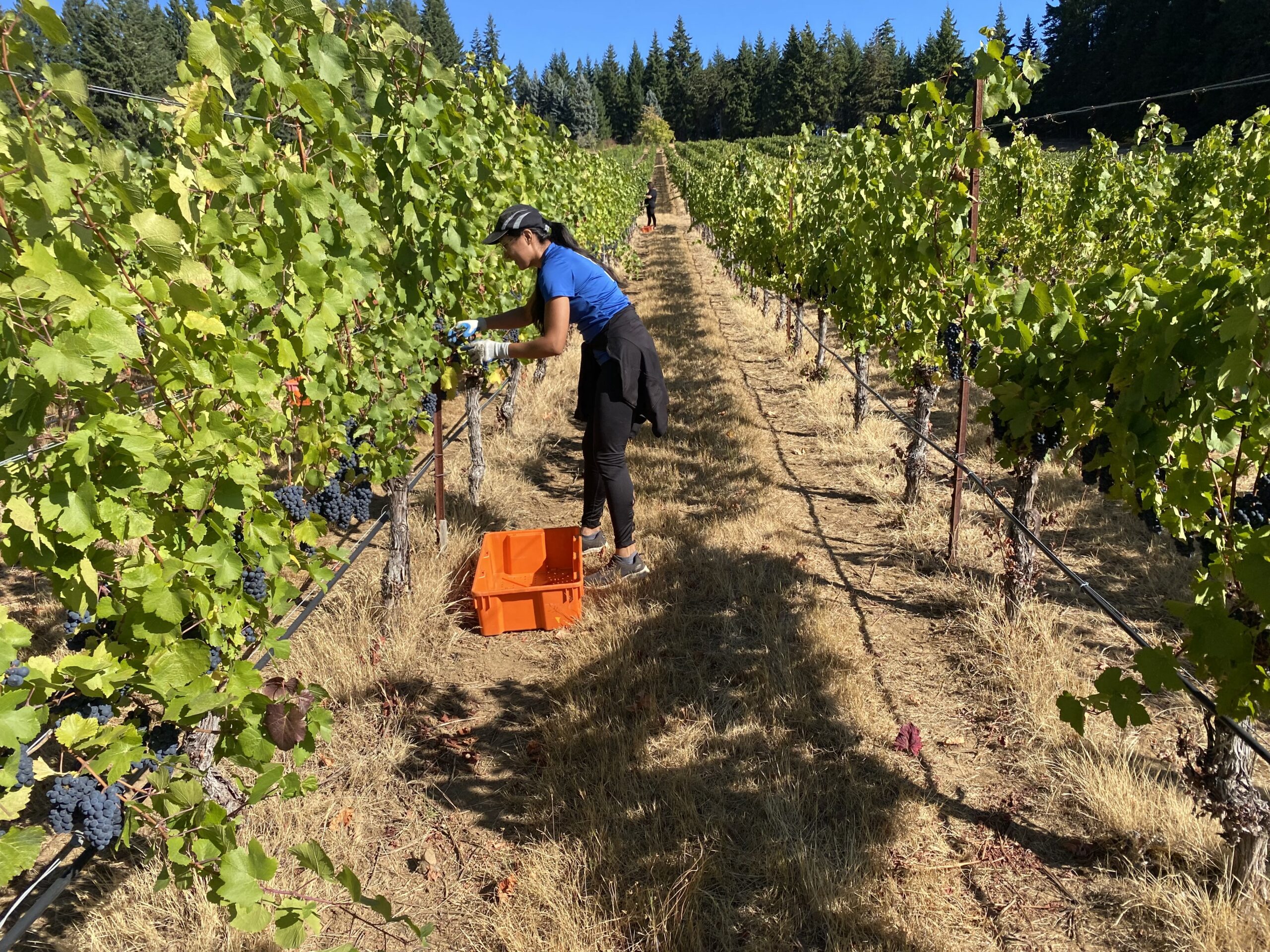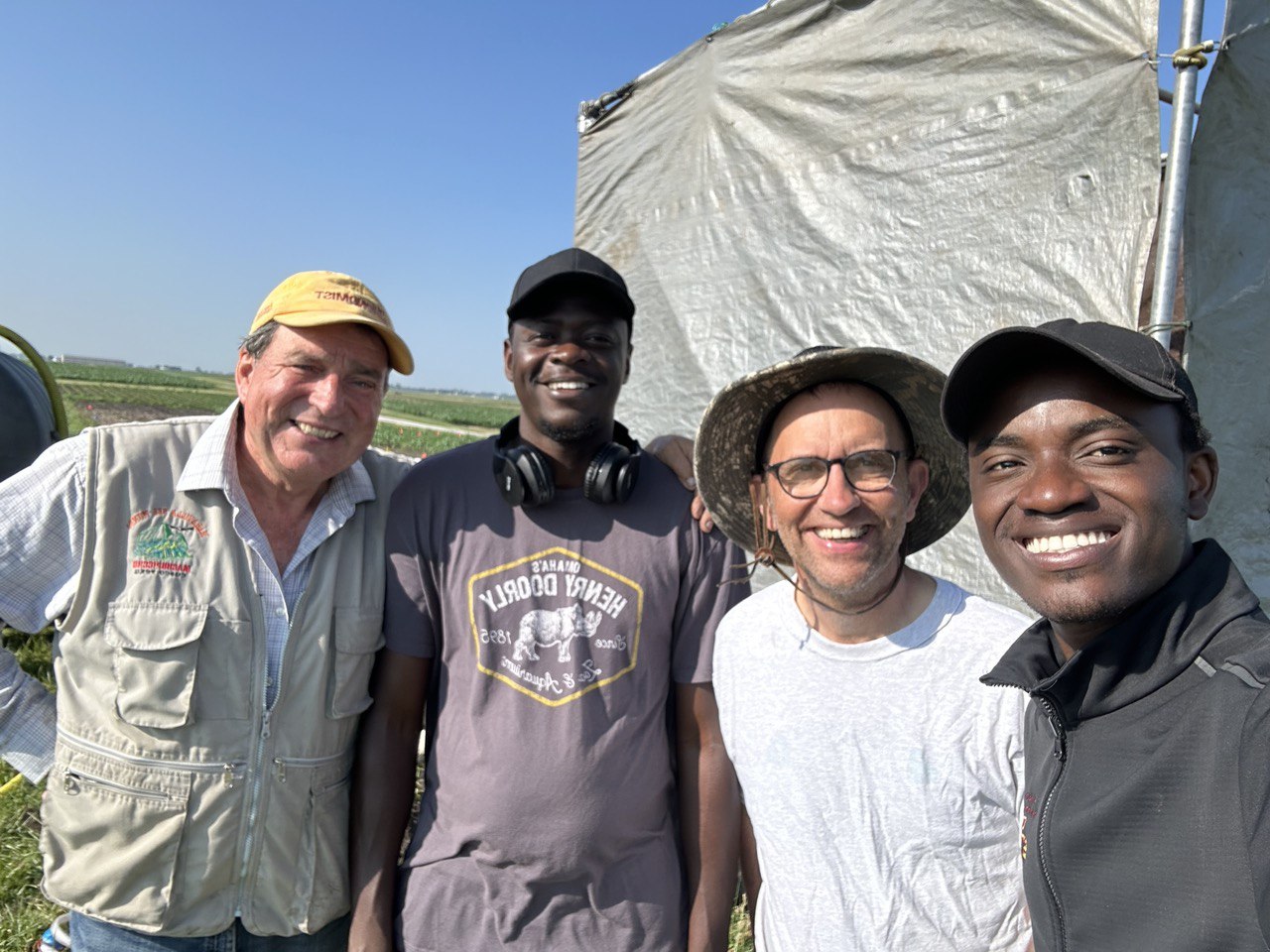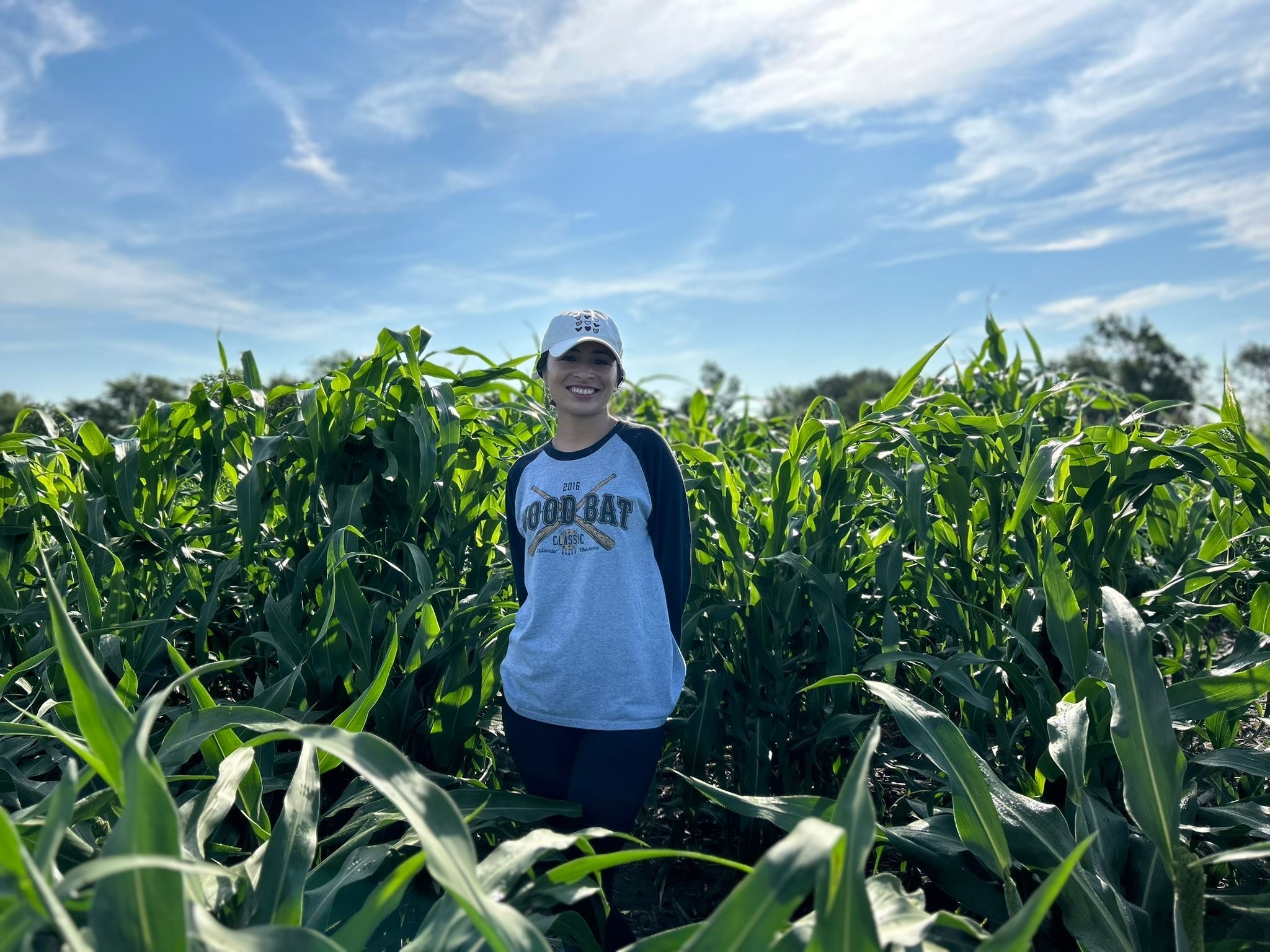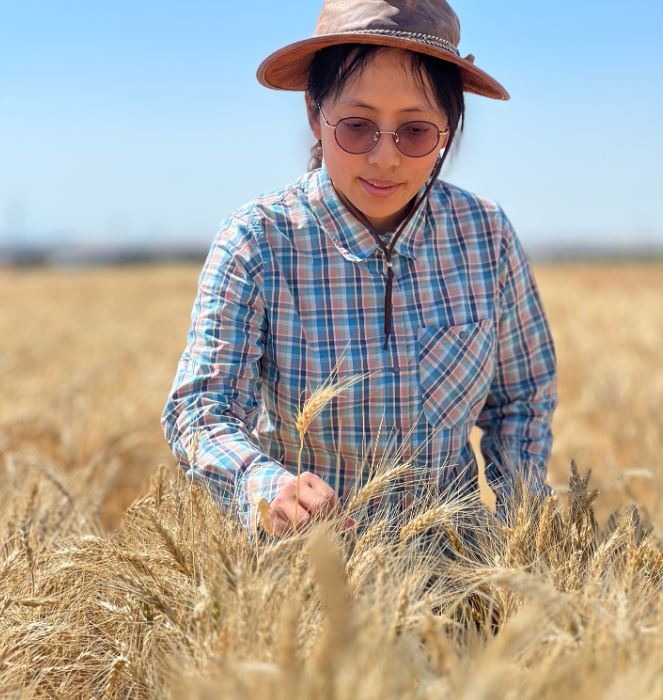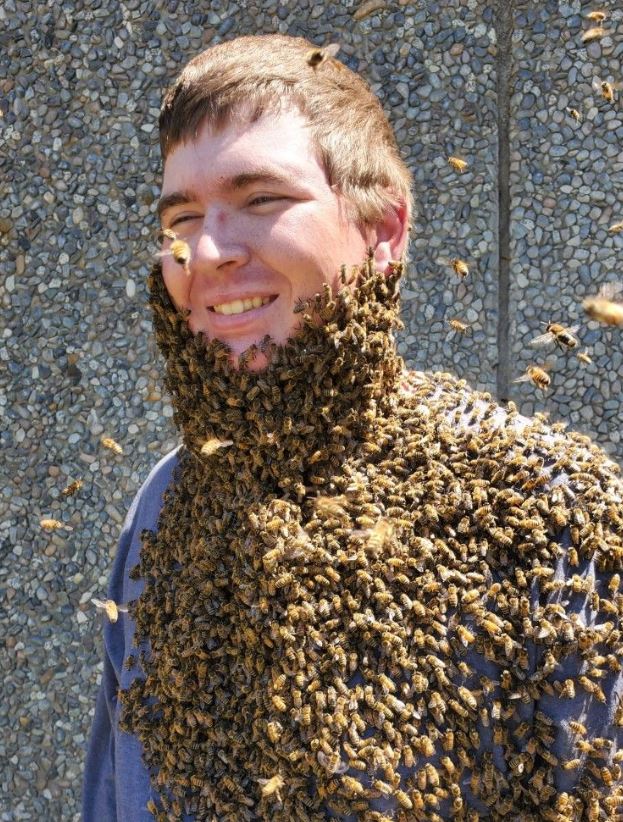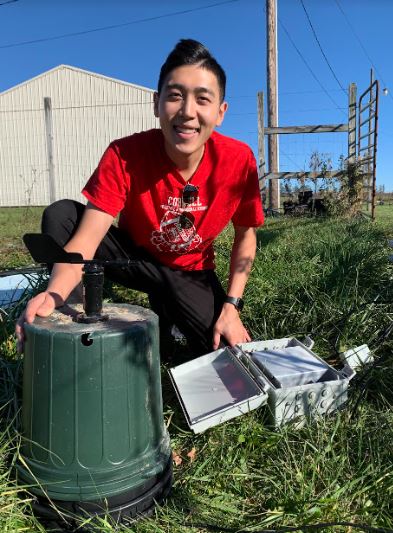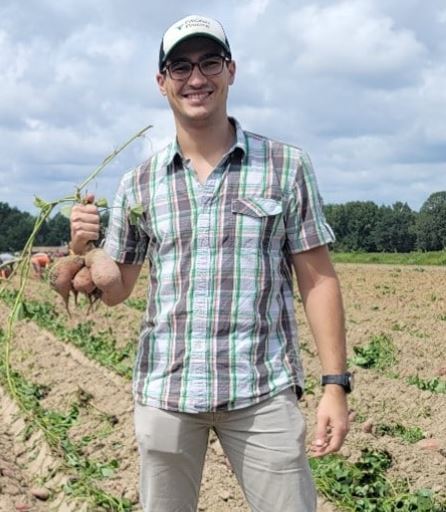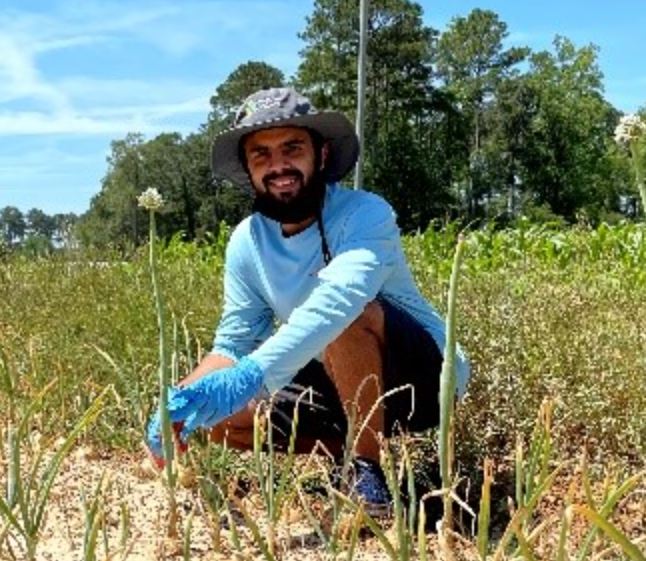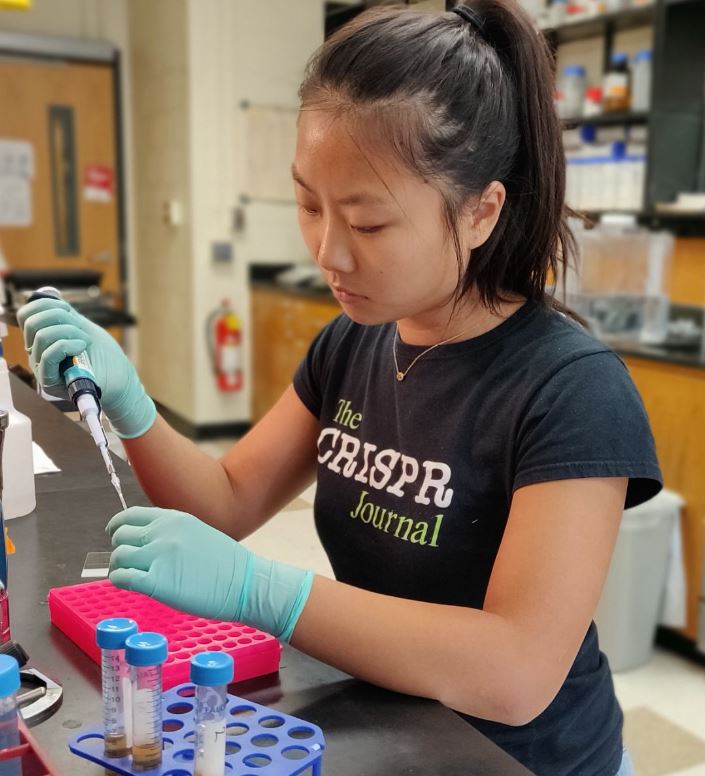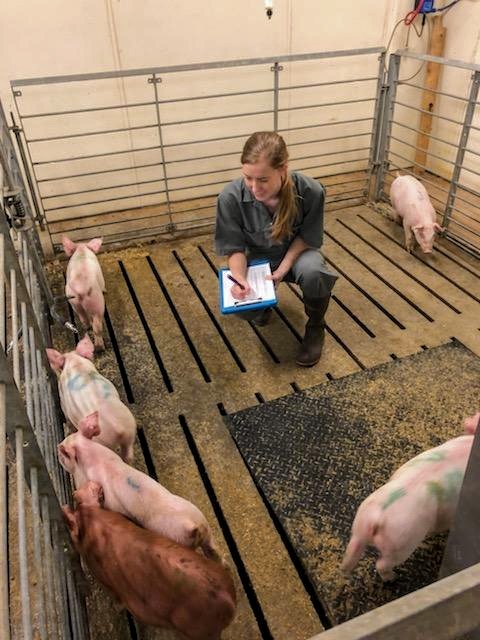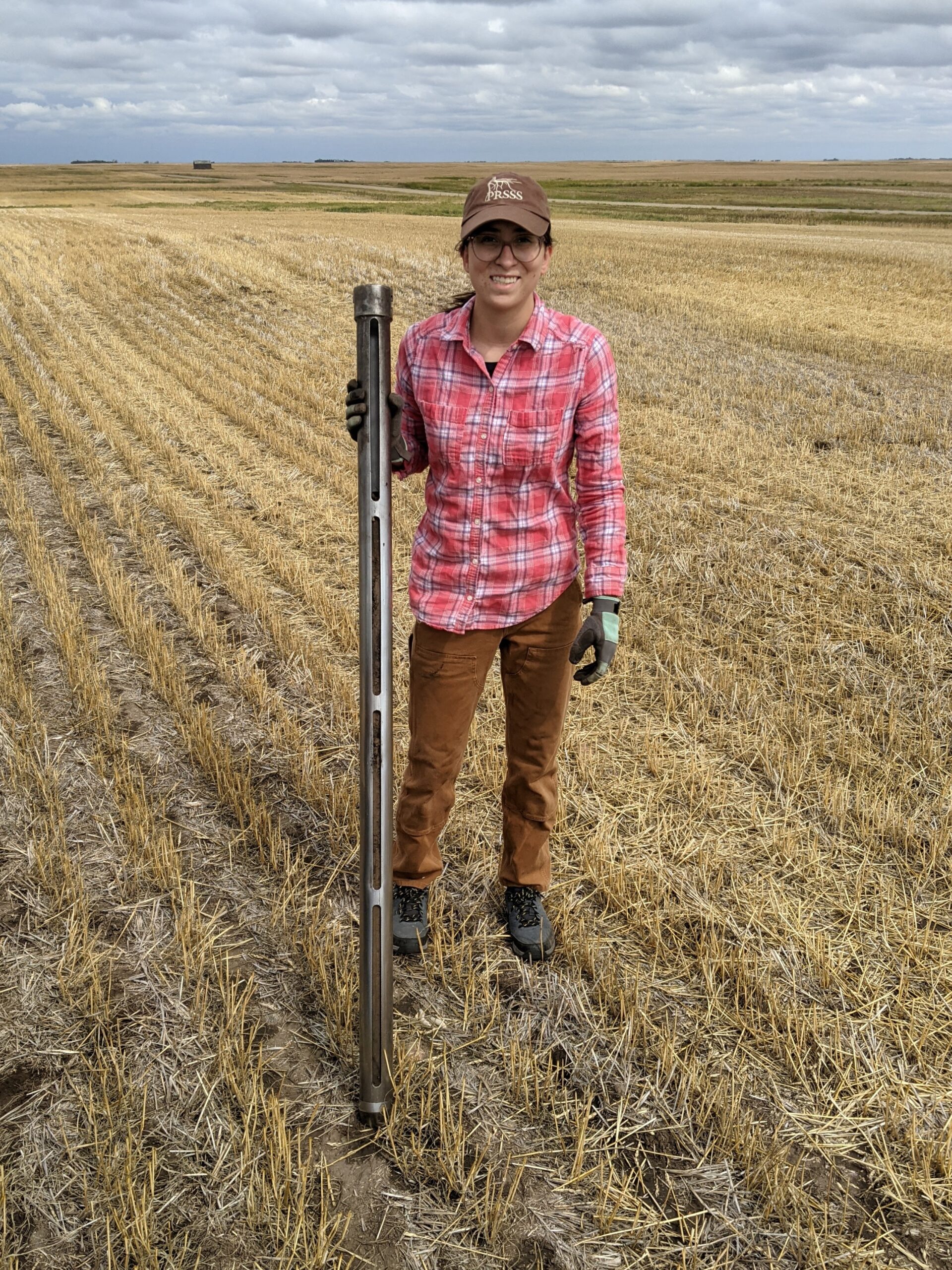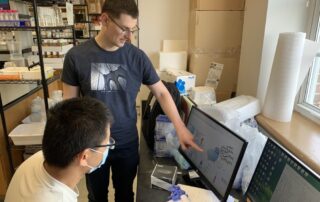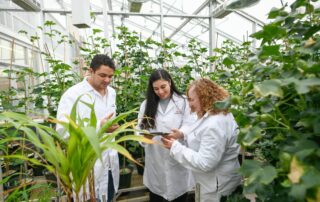From the FFAR Blog
Designing Sentinel Plants to Monitor the Invisible: A New Approach to Soil Health
By Yunqing Wang, 2023-2026 FFAR Fellow
at the California Institute of Technology
Beneath every crop lies a dynamic and invisible ecosystem that plays a vital role in agriculture: the rhizosphere. Microbial communities in this zone drive nutrient cycling, influence greenhouse gas emissions and impact plant productivity. Yet, despite their central role in ecosystem health, we lack the tools to monitor their activity in real time and at scale.
As a FFAR Fellow at the California Institute of Technology, I am developing a sentinel plant platform to serve as a living biosensor to enable aboveground detection of microbial gene activity in the soil. The vision is to create a system that functions like a “molecular window” into the rhizosphere – similar to how Green Fluorescent Protein (GFP) revolutionized cellular biology by allowing scientists to track gene expression and protein activity inside the cell.
Engineered ‘Brown Thumb’ – A Story of Interdisciplinary Research
By Grace Vincent, 2023-2026 FFAR Fellow
at North Carolina State University
In a world where interdisciplinary research is increasingly necessary to solve complex challenges, the ability to step outside one’s field has become essential. Nowhere is this more evident than in efforts to ensure global food security, where plant science, engineering and artificial intelligence must converge to help growers combat crop diseases and improve yields.
Traditional disease identification methods rely on manual surveying, which is time-consuming, labor-intensive and prone to human error. Meanwhile, global crop losses due to biotic stressors amount to an estimated $60 billion annually, making timely mitigation efforts crucial to reducing yield loss. As agricultural challenges grow in complexity, there is a continued need for data-driven solutions to provide faster, more accurate disease recognition.
Vineyard Armor: Developing Solutions to Protect Wine Grapes from Wildfire Smoke
By Lindsay Garcia, 2022-2025 FFAR Fellow
at Oregon State University
The devastating impact of wildfires has grown to be a worldwide concern. In recent years, the most notable destructive wildfires were the 2023 Canadian wildfires and the 2020 Australian bushfires. The 2023 wildfire burned around 4% of Canada’s forest land, marking the largest forest loss in the nation’s recorded history. Meanwhile, the 2020 bushfires became Australia’s most costly wildfire disaster. While the visible destruction of wildfires often captures the media’s attention, there are less obvious effects that can be equally significant. One such impact is in agriculture, specifically vineyards. Smoke from wildfires contains compounds that pass through the grape skin, altering the flavor of the wine. These smoke compounds, called volatile phenols, produce smoky, ashy, and medicinal sensory attributes to the affected wine. Since many wine consumers dislike smoky characteristics in their wine, winemakers lose thousands of dollars from reduced sales. Combined with the physical damage to vineyards, wildfires lead to significant financial losses. For example, the wine industry was hit with an estimated loss of $3.7 billion from the 2020 wildfires alone.
Computer Modeling of the Perennial Groundcover System: The Place of Team Science
By Oluwatuyi Olowoyeye, 2023-2026 FFAR Fellow
at Iowa State University
The Perennial Groundcover (PGC) system is a potential shift away from conventional land management and crop production in the U.S. Unlike traditional cover crops that are terminated and replanted annually, the PGC system provides year-round living cover that grows simultaneously with row crops. PGC has all the benefits of traditional cover crops, including erosion control, water retention and nutrient conservation, but extends these benefits to the entire year. My research as a FFAR Fellow at Iowa State is focused on modeling the ecosystem services in this novel system. Field trials, while essential, are limiting because they can’t include a broad range of scenarios. Modeling allows us to move beyond the limits to simulate, test and forecast the behavior of PGC across various climates, soils and management practices. Yet, modeling PGC is not a plug-and-play endeavor. Because the system involves growing two plants simultaneously, we need to adapt known parameters (like soil moisture, leaf area index etc.) and calibrate new ones (like grass planting operation, soil layer thickness etc.) to fit existing process-based models like Environmental Policy Integrated Climate (EPIC) and Agricultural Production Systems Simulator (APSIM). What makes this research effort unique is the collaborative foundation on which it is built.
Tackling Research Challenges with Interdisciplinary Collaboration
By Mariana Prieto-Torres, 2022-2025 FFAR Fellow
at North Carolina State University
Cucurbit crops include beloved fruits and vegetables such as cucumber, squash, watermelon, melon and pumpkins. These crops are exposed every year to the disease cucurbit downy mildew which reduces yield and quality of the fruit . Farmers currently manage downy mildew with weekly fungicide applications, which commonly start a few weeks after the seeds have been planted. These fungicide applications are more effective when they are applied preventatively at very early stages of the disease. My research as a PhD student and FFAR Fellow at North Carolina State University is about optimizing the use of fungicides to have the most effective disease management while reducing the number of fungicide applications
From Seeds to Leaves: How AI is Revolutionizing Plant Breeding
By Nikki Shrestha, 2022-2025 FFAR Fellow
at the University of Nebraska-Lincoln
Plant breeding has come a long way since farmers first began saving seeds from the best plants thousands of years ago. Today, breeders use cutting-edge tools like genomic sequencing to identify genes linked to specific traits of interest. My research focuses on improving how we measure these traits, which is crucial for accurately finding the genes responsible for them.
Cultivating Tomorrow’s Wheat Scientists: Mentoring Undergraduate Researchers
By Mei Ling Wong, 2022-2025 FFAR Fellow
at Montana State University
The goal of my project as a FFAR Fellow in the wheat breeding program is to verify genetic components that influence the number of grains per wheat head and pinpoint the genes that determine these, potentially increasing grain yield for wheat producers. We are testing two variants of a genetic region (alleles): one associated with high grain number, the other with low grain number. The data collection process requires measuring a wide range of plant characteristics, such as height, leaf area and grain number. These traits are necessary for evaluating the performance of breeding lines and understanding the complex trade-off between different traits in plants, factors important for developing high-yielding varieties. However, measuring numerous traits is labor-intensive and time-consuming, particularly when dealing with a large number of plants.
To be honest, most of the work that we needed help with in the breeding program was not the most groundbreaking or exciting, but was crucially necessary for the project’s success. For example, weeding in fields, cleaning seeds, threshing wheat heads and washing pots. An unexpected but critical challenge for our research became this: If scientific research requires many tedious and repetitive tasks like these, how can we ensure that undergraduate researchers remain engaged and motivated in our lab?
A Journey Toward Breeding the Beloved Blueberry
By Heeduk Oh, 2022-2025 FFAR Fellow
a North Carolina State University
Blueberries are a beloved fruit, enjoyed for their pleasant flavor and health benefits. The production of blueberries has increased almost 5-fold during the last 20 years largely due to successful breeding efforts that have expanded the areas suitable for their production. My research is focused on helping breeding programs develop blueberry varieties with a firmer texture that is appealing to consumers while protecting the berries from damage during harvest and transport.
Fruit texture is one of the fruit quality traits that can change drastically during transport and storage and can have significant consequences on both consumer experience and marketability. Currently cultivated varieties (cultivars) often produce fruit with variable texture that fails to consistently meet consumer expectations. Moreover, fruit from most cultivars are insufficiently firm and susceptible to internal bruising, making it challenging for machine harvest. As a result, developing blueberries with firmer berries that do not soften quickly during storage has become a crucial goal for breeding programs.
The Science Behind Your Favorite Snack
By Samuele Lamon, 2022-2025 FFAR Fellow
at the University of Georgia
The history of peanuts is fascinating. They originated less than 10,000 years ago from the natural crossbreeding of two wild species, Arachis duranensis and Arachis ipaënsis. This crossbreeding was followed by polyploidization, where the hybrid offspring ended up with four sets of chromosomes instead of two. Although initially reducing genetic diversity and isolating peanuts from closely related species, polyploidization also led to significant changes in peanut DNA, increasing their genetic diversity over time. Today, peanuts are incredibly diverse, with two subspecies, six botanical varieties, four major market types and thousands of landraces and cultivars. My research focuses on these DNA changes and the effects of genetic instability in peanut crops. By understanding the frequency and location of these changes in peanut chromosomes, we aim to help breeders create new peanut varieties that meet current agricultural needs and reduce farming’s environmental impact.
Feeding Bees Through Diversity
By Riley Reed, 2022-2025 FFAR Fellow
at Washington State University
Insects are responsible for pollinating many of our favorite foods ranging from apples to chocolate. In fact, nearly 100 crops globally either require or benefit from animal pollination. Many different animals are capable of pollinating, including bees, flies, beetles, and even bats, but honey bees are by far the most widely used pollinators in agriculture. Honey bees generally work really well with our agricultural system, allowing migratory beekeepers to quickly transport huge numbers of pollinators to a blooming crop and then remove them just as quickly when they are no longer needed. Of course, the delicious honey they make certainly sweetens the pot too! Unfortunately, this system isn’t quite as good for the bees. Honey bees need a much more diverse diet than they can acquire from a single crop, forcing some of the bees to look for food outside the field or orchard. Normally this isn’t a problem because there are still plenty of bees in the field, but for seed crops this presents a big risk.
Precision Agriculture Tools for Livestock Production
By Caleb J. Grohmann, 2021-2024 FFAR Fellow
at the University of Missouri
Livestock producers make several critical decisions daily that impact the health of animals and the farmer’s bottom line. Yet the supply of quality livestock technicians and managers who can make these decisions is decreasing across all sectors of animal agriculture, especially in the United States swine industry. Precision livestock farming technologies offer an interesting opportunity to provide support in making accurate decisions that positively impact the productivity and sustainability of swine operations. In my Ph.D. research at the University of Missouri–Columbia, we are striving to build tools to help pig farmers proactively and positively impact pig survivability in wean-to-finish pig barns.
Transforming Agriculture with Data and Artificial Intelligence
By Shiang-Wan Chin, 2021-2024 FFAR Fellow
at Cornell University
In an era in which sustainable agriculture is not just a choice but a necessity, my research with Dr. Hakeem Weatherspoon at Cornell University introduces a groundbreaking decision support system named Real-Time Optimization and Management System (ROAM). This innovative system is the cornerstone of my research, signifying an advancement in the realm of Digital Agriculture (DA).
ROAM isn’t merely a technological advancement; it’s the embodiment of a new era of data in farming called digital agriculture. By integrating state-of-the-art networking technologies and sophisticated data analysis, ROAM transforms traditional farms into network-enabled farms. This revolutionary technology enables farms to make data-driven decisions and optimize operations in real-time for better productivity and sustainability.
Central to ROAM is the Many-Objective Robust Decision Making (MORDM) framework. This advanced framework is integrated into an intuitive user interface, offering farmers a seamless and efficient decision-making tool. MORDM’s ability to handle multiple objectives and variables makes ROAM even more broadly applicable to providing robust and adaptable solutions to the ever-changing challenges in agriculture
How Our Waste Can Improve Soil Health in Semi-Arid Dryland Cropping Systems
By Madeline Desjardins, 2022-2025 FFAR Fellow
at Washington State University
Like most people, I once spent virtually no time thinking about the content of toilets and where those contents went after a flush. This all changed when I began my Ph.D. work in Dr. Deirdre Griffin LaHue’s Soil Health Lab at Washington State University. With funding from the FFAR Fellows Program and the King County Wastewater Treatment Division, my graduate research focuses on how biosolid byproducts from our waste stream can improve soil health and support sustainable agricultural production.
My research focuses on how biosolids influence the physical, biological, and chemical soil health properties of semi-arid dryland grain systems, and whether biosolids can help growers establish cover crops in these systems. The geography of this research is in dryland systems in Central Washington. These systems face some specific challenges related to water availability that can severely limit crop yields. Annual precipitation in this area is low (~10 inches of precipitation a year), and these systems rely solely on precipitation to meet the water needs of the crop (this means they are completely unirrigated).
The Innovation Dilemma: Why Adoption Rates for Agricultural Technologies Lag Behind
By Enrique Pena, 2021-2024 FFAR Fellow
at North Carolina State University
Occasionally, I will read an article that a friend, family member or colleague has shared with me about groundbreaking advancements in agriculture, and it usually starts with a title like “All in one planter: till, seed, and fertilize in a single pass” or “Autonomous tractors! Let a robot farm for you”. I always think, “Wow, this is really cool!” And then, I notice little interest from farmers to adopt these technologies. Despite being available in the marketplace, many of these innovations do not gain enough traction to become normalized in the industry. Drones provide a good example of this, as farmers have been reluctant to invest in these despite the decades the technology has been available. Over time, I have seen the gap widen between the number of innovations breaking into the market and the number of farmers adopting them. Why is this the case? I believe that we, as scientists and innovators, need to improve our communication strategies to boost the adoption of valuable agricultural technologies.
Building Team Chemistry, The Bigger Picture Behind Cows and Climate
By Conor McCabe, 2021-2024 FFAR Fellow
at the University of California-Davis
How does cattle production impact the climate? Microbes that reside within the stomach of cows break down the grasses and plants they eat. These microbes also form the greenhouse gas methane, which is released into the atmosphere via cattle burps. Our lab studies various plant compounds, products and feed ingredients that have the potential to reduce this methane source. While a single graduate student coordinates the design of one of these studies and leads it to completion, it takes a dedicated team to make it all happen. As the lead graduate student on a recent project, it was my role to recruit, manage students and create community, which made for a challenging but invaluable growth experience as an aspiring scientist….
Protecting the Vidalia Onion
By Sujan Paudel, 2021-2024 FFAR Fellow
at the University of Georgia
Within the U.S., Georgia is famously known for its Vidalia onion industry. These onions were first grown in Toombs County, South Georgia. Their unique flat shape with a sweet taste led to immediate popularity among growers and consumers. The distinct quality of this onion is due to the low amount of sulfur in the soil which cuts down the acidity and pungency making them sweeter than most other varieties. The continued growth of the industry and Vidalia’s increasing popularity did create branding problems where onions brought from outside were bagged and sold as Vidalias. The Federal Market Order 955 in 1989 defined the growing regions and mandated the growers to register and use specific varieties that provided national protection to the industry. This branding support and advancements in storage conditions oversaw the further growth of the industry which accounts for a staggering $160 million farm gate value and is now spread across 12,000 acres in 20 counties of South Georgia. My research, as a plant pathology Ph.D. candidate at the University of Georgia, aims to help protect this industry from deadly bacterial diseases..
Going Nuts: Nut Crops as Climate Resilient Protein Alternatives for the Future
By Matt Davis, 2022-2025 FFAR Fellow
at University of California – Davis
With the impact of climate change on agriculture becoming ever-more apparent, food producers and researchers need to be able to adapt quickly to environmental pressures. A greater reliance on nut crops could play an important role in this adaptation. Nuts are nutritionally dense and one of the most climate efficient food sources of protein. For example, producing 100 grams of beef protein generates almost 50 Kg of greenhouse gases, which is more than 150 times the greenhouse gas emissions produced for the same amount of nut protein.
Building Bridges Between Academics & Farmers
By Ellie Ellis, 2021-2024 FFAR Fellow
at Colorado State University
Some people claim there is a growing disconnect between agricultural research and the farmers who are supposed to benefit from the findings of this research.While controlled experiments are great for understanding specific agronomic outcomes, they are not well suited for studying the impacts on farm economics, neighboring farmers, or the surrounding ecosystem.
Engineering Beneficial Bacteria to Improve Human Health
By Echo Pan, 2020-2023 FFAR Fellow
at North Carolina State University
Though we are only just beginning to understand the many ways in which microorganisms impact health, the advance of next generation genetic sequencing technologies has enabled us to reveal the composition of the human microbiome. Scientists are working to better understand the interactions between the microbiome and the human host, as well as potential ways to manipulate the microbiome to improve health.
How Heat Stress Impacts Swine Health
By Lauren Anderson, 2020-2023 FFAR Fellow
at North Carolina State University
As temperatures increase, it not only impacts human health but also can be a major threat to swine agriculture. Pigs are disproportionately affected by heat stress due to their physiology. They can only sweat at about two percent of the rate of the average human, so their ability to dissipate heat by evaporative cooling (through sweat) is virtually non-existent.
Wetlands: Agricultural Soil & Water Management for a Changing Climate
By Chantel Chizen, 2021-2024 FFAR Fellow
at University of Saskatchewan
Like the seasons, there are natural drought-flood cycles where we experience a back and forth between years of little precipitation leading to drought and other years with heavy precipitation that can cause flooding. However, with climate change these weather extremes are expected to be more intense and the patterns may become difficult to predict.One strategy that can increase crop production’s resilience to extreme weather is maintaining wetlands within cropland.
Throwing a Wrench in the Pesticide Treadmill
By Swati Mishra, 2021-2024 FFAR Fellow
Adorned in beautiful black and golden stripes, the Colorado potato beetle (CPB) is a perfect example of the saying, “all that glitters isn’t gold.” These charming and seemingly innocuous beetles cost potato farmers tens of millions of dollars annually. A single young beetle can eat up to 40 centimeters of leaf surface every day, which is about half the size of a sheet of copy paper. Combine that with a reproduction rate of about 500 eggs per female, leaving a potato field with nothing but plant skeletons.
Building Tools for Plant Genome Editing
By Simon Sretenovic, 2020-2023 FFAR Fellow
Researchers and plant breeders are diligently working to secure global food security. While the population increases, the amount of arable land is decreasing. Climate change is also contributing to the growing uncertainty about future food supplies due to its impact on crop yields. Yet, all is not lost. My research at University of Maryland is addressing this problem at a fundamental level by improving the gene editing toolkits that are at the center of cutting-edge research to develop high-yield and climate-resilient crops.
Archea, Microbial Superheroes?
By Jabeen Ahmad, 2021-2024 FFAR Fellow
Food insecurity is a concern now and in the future. Globally, the United Nations estimates that about 690 million people are food insecure. By the year 2050, the world population is expected to reach nine billion people, requiring food supplies to double. While the demand for food grows, fertile, arable land is decreasing and extreme weather events are increasing, making the task of feeding everyone more difficult. With climate change, the problem is further exacerbated as pest and pathogen ranges expand and habitable zones for crops change. Plants need to be stronger and hardier. At the same time, we need to implement more sustainable crop management practices that lessen chemical inputs such as fertilizers and pesticides. The challenge seems intractable.

